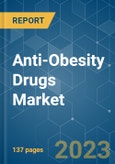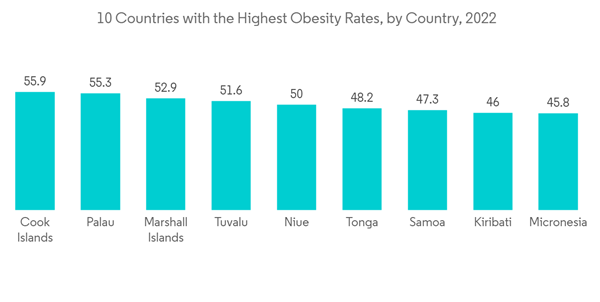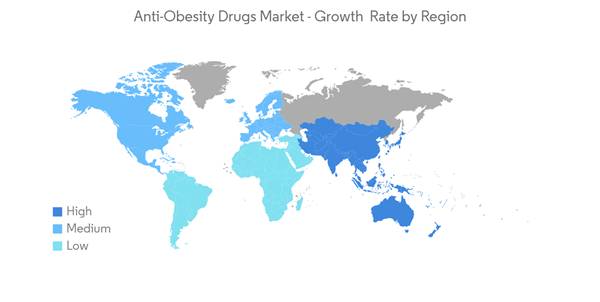During the COVID-19 situation, it was observed that obesity had increased exponentially. As per an article published by the European Journal of Nutrition in December 2020, the rate of obesity has increased in the world. The primary reason is a change in lifestyle and a decrease in exercise practice among people as they avoided gym and yoga classes due to the social distancing protocols. Similarly, according to the article published in Diabetes Obesity and Metabolism in August 2021, obesity prevalence is a significant and potentially modifiable risk factor for increased COVID-19 national caseload and mortality. This increased risk of the obese population leading to COVID-19 mortality which increased the demand for anti-obesity drugs during COVID. However, increased awareness about healthy lifestyle and weight concerns during the pandemic are expected to maintain the demand of anti-obesity drugs even post-pandemic period.
According to the World Health Organization’s report published in June 2021, 39 million children under the age of 5 years were overweight or obese in 2020. One in five children and adolescents globally is overweight. Incidences of obesity have been increasing fiercely over the past decades, and it is often described as a global endemic, especially in developed countries where lifestyle-related disorders, such as anxiety, stress, smoking, and drinking, are more prevalent. Owing to the increase in the obesity population worldwide, the key players in the market are initiating product developments and seeking market approvals. For instance, in January 2021, Novartis AG announced the results of its Phase II trial of the investigational product drug called Bimagrumab. The drug has shown potential for the indication of obesity. The drug is currently being studied in the Novartis pipeline. This may result in new treatment options, boosting market growth over the forecast period.
In addition, research on several potential drug molecules that target both obesity and Type 2 diabetes mellitus has become a key trend among the anti-obesity market players. The increasing epidemic of obesity and Type 2 diabetes is encouraging researchers and vendors in the market to research drugs that can counter both obesity and Type 2 diabetes. Hence, the increasing obese population, rise in unhealthy eating habits, and sedentary lifestyles are expected to drive the market growth over the forecast period.
However, the availability of alternative therapies and the potential side effects of anti-obesity drugs are expected to restrain the market growth.
Anti-obesity Drugs Market Trends
The Prescription Drugs Segment is Expected to Exhibit a Faster Growth Rate Over the Forecast Period
By drug type, the prescription drug segment is expected to hold a significant market share. During the pandemic, different companies looked into new classes of medicines that help people lose weight and control diabetes as a possible way to fight the pandemic disease since COVID-19 had serious effects on the obese population. In June 2021, Novo Nordisk's weight-management drug received FDA approval. Such research and development activities are expected to propel the demand for prescription drugs. Moreover, the rising intake of junk foods and fast foods is resulting in declining health among the population worldwide, leading to an increase in the prevalence of obesity, especially in some developed parts of the world. For instance, according to the Eurostat report in July 2021, more than half (53%) were overweight (36% pre-obese and 17% obese) in Europe. Furthermore, for people aged 75 or over, the older the age group, the higher the share of overweight people: the lowest share was recorded among those aged 18 to 24 (25%), while those aged 65 to 74 had the highest share (66%). In June 2020, China Medical System Holdings signed a USD 400 million-plus agreement for Chinese commercialization rights to US biotech company Gelesis Inc.’s prescription obesity management product, Plenty. All these developments by the players, coupled with increasing awareness of prescription medicine, are anticipated to boost the growth of the prescription drugs segment.Because of this, the above factors are likely to drive segment growth in the market over the next few years.
North America is Expected to Dominate the Market over the Forecast Period
North America is expected to dominate the global anti-obesity drugs market. The primary factors driving the growth of the market studied are the increase in the obese population and high healthcare spending. According to an article published by SingleCare Administrators, in February 2022, 1 out of every 3 U.S. adults is obese. Non-Hispanic black women experience the highest rates of obesity in America at 59%. Obesity rates are higher for Hispanic, Mexican American, and non-Hispanic black populations than for Caucasians. The South and the Midwest have the highest obesity prevalence. All U.S. states and territories have an obesity rate of at least 20%.The high obesity rate has always attracted key players to make developments in the region. For instance, in 2020, Kintai Therapeutics, a US-headquartered company, announced that it was working across therapeutic areas and is beginning IND-enabling studies for its first potential therapeutic for treating obesity. The first drug candidate is KTX-0200, which has demonstrated sustained weight loss and improvements in other markers of health in animal models. The launch of these pipeline products and the increasing geographic footprints of the players are expected to propel the market growth in this region.
Anti-obesity Drugs Market Competitor Analysis
The anti-obesity drug market is moderated due to the presence of companies operating globally and regionally. The competitive landscape includes an analysis of a few international as well as local companies that hold a significant market share and are well known, including GlaxoSmithKline PLC, Novo Nordisk AS, Pfizer Inc., F. Hoffmann-La Roche AG, and Bayer AG.Additional benefits of purchasing the report:
- The market estimate (ME) sheet in Excel format
- 3 months of analyst support
This product will be delivered within 2 business days.
Table of Contents
Companies Mentioned (Partial List)
A selection of companies mentioned in this report includes, but is not limited to:
- Alizyme
- Bayer AG
- Bristol-Myers Squibb
- Currax Pharmaceuticals LLC
- F. Hoffmann-La Roche AG
- GlaxoSmithKline PLC
- Merck & Co. Inc.
- Norgine BV
- Novo Nordisk AS
- Pfizer Inc.
- Rhythm Pharmaceuticals
- Takeda Pharmaceuticals
- Vivus Inc.
- Zafgan
- Zydus Cadila










